Every project involves four essential project management basics:
- Project scope: This refers to the nature of the project. What are the goals? What’s the size of the project, and what elements comprise it? What’s required to complete it? The project scope covers all these areas.
- Resources: Every project requires resources to get the job done. This could be people, equipment, or other items needed to complete the project.
- Time: Depending on the scope, the project could take days, weeks, or longer to complete. Since the project timeline affects business objectives and vice versa, it’s important to understand when a project can be completed.
- Budget: Every project has a cost. Understanding that cost affects project profitability.
Tracking and managing these four elements is the template for achieving the desired outcome of a project management plan. For instance, meeting the project scope but failing to do so on time grants competitors an opportunity, like being first to market with a similar solution. And project management tracking becomes progressively more difficult as the size and complexity of the project grows, increasing the risk of failure.
That’s where project management software saves the day. This specialized group of project management tools alleviates the challenges in tracking and managing the four key project elements.
Why do you need to track your project progress?
Some may ask why tracking project progress is even necessary. After all, it can seem like administrative overhead. And it might be for a simple project that takes just a few days and involves one or two people.
For larger projects that can take weeks or longer, and are comprised of several people, project tracking becomes critical. It increases the likelihood of a successful outcome by delivering these benefits:
- Improved communication: Many projects involve groups of people, both those who work directly on the project as well as stakeholders who need to know how the project is doing but aren’t involved, like the CEO of a company. Documenting the project plan as well as progress against that plan is an effective tool to communicate where things stand to all groups. Moreover, it identifies when challenges arise, such as falling behind schedule, so that everyone is aware and can find solutions.
- Efficient resource management: To complete a project on time and on budget, you’ve got to manage your resources. This means team members are assigned work so they know their responsibilities and deadlines, which also ensures work does not overlap across staff. In addition, project tracking allows visibility into factors like when necessary equipment will become available, which can affect project timelines and priorities.
- Better scheduling: With project tracking, you assign each task estimated timeframes for completion and schedule these tasks so that milestones and deadlines are met, ensuring a project adheres to its timelines.
- Superior budget management: As part of the project tracking process, actual expenditures should be monitored and compared against estimated costs to confirm budgets are adhered to. This enables the team to adjust during the course of the project if expenses get out of hand, so that by the end of the project, the team has met the project cost requirements.
How you can track your project
Project management is fortunate to have a wide array of software tools that make project tracking a breeze. Gone are the days when a spreadsheet is your only option.
Here’s a summary of some excellent and well-known software tools to track your project. Let’s dive into how each can help.
With Podio
Podio is a strong option to meet your project tracking needs. It contains all the core functionality involved in the project management steps, such as time tracking and budget reports.
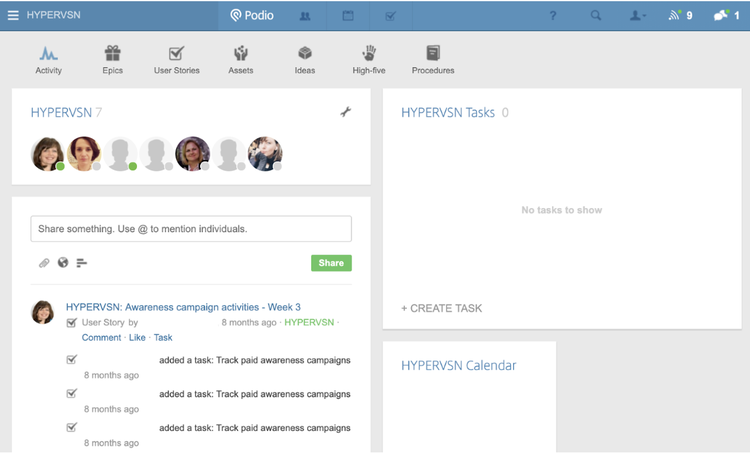
Podio’s main dashboard is simple, allowing for easy navigation. Image source: Author
Source: Podio software.
In addition, if the software lacks a feature you require, its customization capabilities mean you can add it.
With elements like team dashboards, chat features, and a shared team calendar, Podio supports communication and collaboration across project members.
It even offers a free basic version of the software, giving you the opportunity to try Podio before upgrading to a tier with more features.
With monday.com
As a project progress tracker, monday.com is a solid choice. Its functionality covers all phases of the project life cycle. It has many of the same features as Podio, such as budget reports, time tracking, and shared team calendars, and it combines these into a nice user interface (UI).
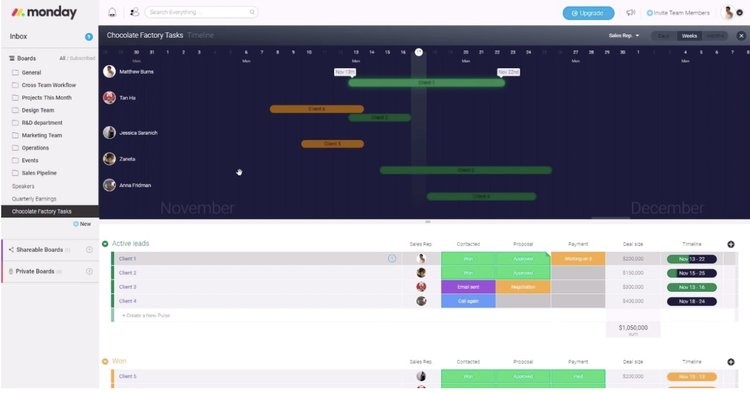
monday.com offers nice visualizations of your projects like this timeline system. Image source: Author
As a result, monday.com is a complete project management tracking tool, although it lacks the free option provided by Podio.
With Wrike
Like Podio and monday.com, Wrike possesses the essential functionality needed to successfully execute projects. Wrike offers a free version with limited features akin to Podio.
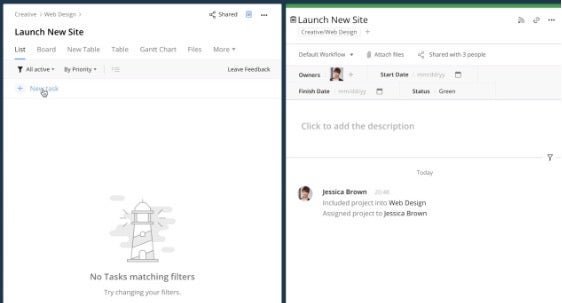
Wrike’s task management system consolidates all work in one spot. Image source: Author
Source: Wrike software.
In addition, Wrike gives users flexibility in how they want to track projects, with traditional task lists, a Kanban board, or other tracking methods which are built right in.
It does include a drawback: you’ve got to be online to use its desktop version.
With Airtable
When it comes to using Airtable for project management, it definitely has everything you’ll need. Airtable’s chief strength is its beautifully-designed UI. Its task tracking employs a gallery feature to make the process visually appealing.
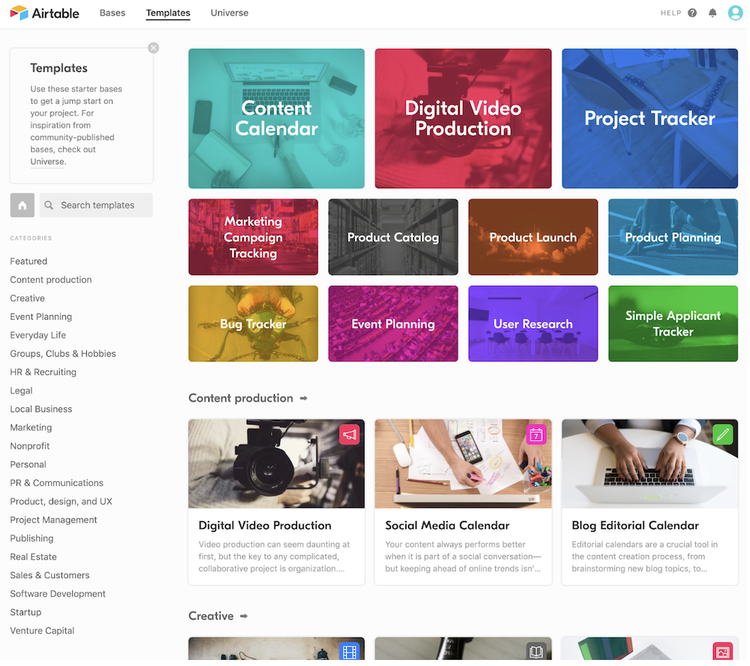
Airtable provides a wide breadth of templates to simplify kick-starting your project. S Image source: Author
ource: Airtable software.
While the software covers what’s needed for managing and tracking any type of project, its built-in tools and templates are particularly fitting for the needs of marketing and ad agency teams.
With Jira
Jira is ideal for teams working on a software development project. That’s where its roots lie and where it continues to show strength even though it could be used for other types of projects since Jira supports the work breakdown structure framework.
So it’s no surprise many companies building software products use Jira. Why it’s particularly apt for such projects is that it’s designed to complement the workflows of an Agile software development methodology.

The Jira setup screen gives a sense for the types of teams and projects its intended for. Image source: Author
For instance, work is intended to be broken down into sprints and assigned story points. As a result, it’s pretty robust for its intended use. I’ve used it at different companies to great effect.
But if you’re not working on a software project or using Agile methodologies, avoid Jira. You’ll quickly become frustrated by its lack of features for broader project management applications, like no budget management, and its reporting designed around Agile software topics like its burndown report.
With Scoro
Fully-featured Scoro delivers all the important project management tracking features found in rivals like Podio.
Capabilities such as time and budget tracking become more robust thanks to Scoro’s strong reporting. This comes through immediately upon logging in and viewing its default dashboard, which is packed with information.

Scoro’s dashboard provides a thorough view of a project. Image source: Author
Source: Scoro software.
Scoro is a great tool, but consequently, it comes with a high price tag.
With Microsoft Project
This is one of the oldest project management software products on the market, and as such, Microsoft Project is worth a mention. It’s essentially an interactive Gantt chart, a type of bar chart that illustrates a project schedule. This is its strength and weakness.
If you’re looking for software that provides a project tracking template in the Gantt format, this is not a bad option, particularly if your company is already using the Microsoft Office suite since Project integrates with the rest of Microsoft’s products.
Microsoft Project offers the familiar menu and taskbar options seen in Microsoft’s other software. S Image source: Author
ource: Microsoft software.
Project once lacked features available from other software tools on this list, but it's undergone updates. It's now a more robust project management tool, offering options such as integrations with other apps to extend Project's capabilities.
With TeamGantt
A stronger alternative to Microsoft Project is TeamGantt. As its name suggests, the software delivers interactive Gantt charts as its core project tracking experience, but with an easier-to-navigate UI than Microsoft Project.
It also offers collaboration and communication components to facilitate teamwork, time, and resource management features, and a simplified reporting toolset, making it very user friendly.
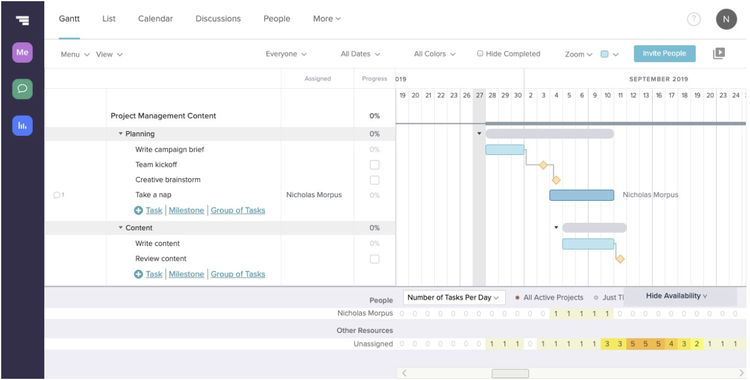
TeamGantt’s take on the traditional Gantt chart delivers a clean, user-friendly interface. Image source: Author
Source: TeamGantt software.
So while other project tracking software can be a project in itself to use, TeamGantt avoids this pitfall.
That said, it lacks budget management features and is expensive, although it does provide a free version with limited capabilities.
Tips for using a project tracker
As you can see, the software options to track and manage projects is pretty varied.
In fact, it can become overwhelming, so let’s touch on how to make the project tracking tool work for you, and not the other way around.
Tip #1: Make sure it meets your needs
Project tracking software is only valuable if it helps you accomplish your goals. If you require the software to track expenses, it’s got to be able to do that or it’s adding a burden rather than helping.
So outline your needs first by listing the key features you must have versus those you can live without, then find the software that meets all of your key needs.
Tip #2: Ease of use is essential
Projects are fluid and ever changing. Priorities shift, task completions get delayed, unexpected challenges arise.
But if making updates to your project plan to reflect these changes is onerous, then your project tracking software is not doing its job. Therefore, pick software that allows you to make quick, easy changes.
Tip #3: It should facilitate communication
The one essential element to any project’s success is communication.
Project tracking software should make this easy with reports that can be downloaded and shared, a dashboard or other means for team members to quickly see the status of their tasks and the project overall, and alerts to help those on the project know when a deadline is missed, changes to a task occurred, or a key milestone is approaching.
That way, you don’t have to constantly live in the software to know what’s going on.
Final advice about project tracking
No one wants cumbersome project tracking software. So if you’re spending twenty minutes trying to figure out how to run a report, that tool needs to go. But you don’t want to discover this when you’re in the thick of your project.
That’s why it’s worth the time to test drive project tracking software through free trials or free basic versions, despite the lack of features. Hands-on experience is the only way to truly know if the software is going to help or hinder.
You’ll get a sense for whether or not the tool fits your needs, and can then commit to paid versions, confident that the project tracking software will help you achieve a successful outcome.
Our Small Business Expert
We're firm believers in the Golden Rule, which is why editorial opinions are ours alone and have not been previously reviewed, approved, or endorsed by included advertisers. The Ascent does not cover all offers on the market. Editorial content from The Ascent is separate from The Motley Fool editorial content and is created by a different analyst team.